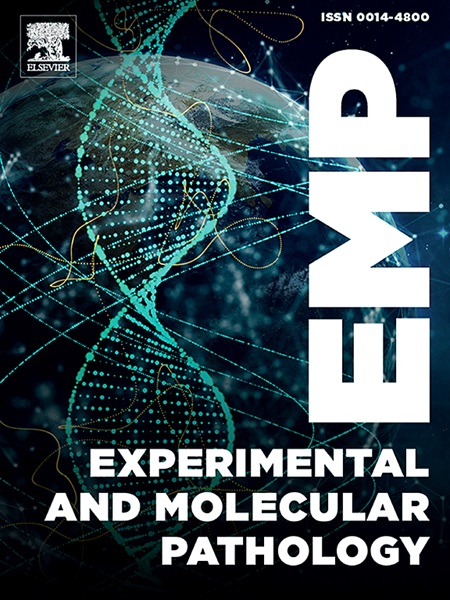有益菌和致病菌之间的交叉喂养利用真核宿主细胞衍生的唾液酸和噬菌体形成病原体-宿主界面环境
IF 3.7
4区 医学
Q2 PATHOLOGY
引用次数: 0
摘要
在肠道发炎的环境下,游离硅酸的增加与某些致病细菌菌株的过度生长有关。最近,肠道噬菌体(噬菌体)的保护性免疫调节活性也得到了强调。然而,迄今为止,噬菌体在致病菌、有益菌及其宿主细胞硅铝酸之间三重相互影响中的作用尚未得到研究。我们利用包含结肠细胞(T84 细胞)、单核细胞(THP-1 细胞)和肝细胞(Huh7 细胞)的人类三重共培养细胞模型,建立了一个硫代硫酸钠酶显式模型,其中有益菌和致病菌通过交叉进食和竞争游离硫代硫酸钠而相互作用。在两种不同的细胞培养基中:1)标准杜氏改良鹰培养基(DMEM);2)含 2,3-脱氢-2-脱氧-N-乙酰神经氨酸(DANA)的 DMEM。评估了受刺激共培养细胞的生理、功能和结构健康指标的变化。对细胞培养上清液中的丝胶酸和促炎细胞因子的浓度进行了量化。P. a PAO1 引发了白细胞介素 6 和 8(IL-6 和 IL-8)的释放,并伴随着游离硅酸水平的升高,降低了共培养细胞的活力,破坏了细胞单层的完整性。KPP22 噬菌体和双歧杆菌能明显减弱这些破坏作用。除了革兰氏阴性致病菌和双歧杆菌在细菌细胞壁的结构和组成上的差异已得到充分证实外,似乎还有两个不同的因素在调节病原体-宿主界面环境中起着关键作用:(i) 噬菌体的存在和 (ii) 双歧杆菌对宿主细胞分泌的游离硅酸的利用。本文章由计算机程序翻译,如有差异,请以英文原文为准。

Cross-feeding between beneficial and pathogenic bacteria to utilize eukaryotic host cell-derived sialic acids and bacteriophages shape the pathogen-host interface milieu
Under an inflamed-intestinal milieu, increased free sialic acids are associated with the overgrowth of some pathogenic bacterial strains. Recently, the protective immunomodulatory activity of gut bacteriophages (phages) has also been highlighted. However, the role of phages in triple reciprocal interactions between pathogenic bacteria, beneficial bacteria, and their host cell sialic acids has not been studied so far. We established a sialidase-explicit model in which beneficial and pathogenic bacteria interact through cross-feeding and competition for free sialic acid using a human triple co-culture cell model incorporating colonocytes (T84 cells), monocytes (THP-1 cells), and hepatocytes (Huh7 cells). Triple co-cultured cells were challenged with Gram-positive Bifidobacterium bifidum (B. bifidum) and Gram-negative Pseudomonas aeruginosa PAO1 (P. a PAO1) in the absence or presence of its KPP22 phage in two different cell culture mediums: 1) standard Dulbecco's Modified Eagle Medium (DMEM) and 2) DMEM with 2,3-dehydro-2-deoxy-N-acetylneuraminic acid (DANA). Changes in physiological, functional, and structural health markers of stimulated cocultured cells were evaluated. The concentrations of sialic acid and pro-inflammatory cytokines in the cell culture supernatants were quantified. P. a PAO1 triggered the release of interleukin 6 and 8 (IL-6 and IL-8), accompanied by increased levels of free sialic acid, reduced viability of co-cultured cells, and disrupted the integrity of the cellular monolayer. These disruptive effects were markedly attenuated by KPP22 phage and B. bifidum. In addition to well-documented differences in the structure and composition of the bacterial cell walls of Gram-negative pathogenic bacteria and bifidobacteria, two distinct factors seem to be pivotal in modulating the pathogen-host interface milieu: (i) the presence of phages and (ii) the utilization of free sialic acids secreted from host cells by bifidobacteria.
求助全文
通过发布文献求助,成功后即可免费获取论文全文。
去求助
来源期刊
CiteScore
8.90
自引率
0.00%
发文量
78
审稿时长
11.5 weeks
期刊介绍:
Under new editorial leadership, Experimental and Molecular Pathology presents original articles on disease processes in relation to structural and biochemical alterations in mammalian tissues and fluids and on the application of newer techniques of molecular biology to problems of pathology in humans and other animals. The journal also publishes selected interpretive synthesis reviews by bench level investigators working at the "cutting edge" of contemporary research in pathology. In addition, special thematic issues present original research reports that unravel some of Nature''s most jealously guarded secrets on the pathologic basis of disease.
Research Areas include: Stem cells; Neoangiogenesis; Molecular diagnostics; Polymerase chain reaction; In situ hybridization; DNA sequencing; Cell receptors; Carcinogenesis; Pathobiology of neoplasia; Complex infectious diseases; Transplantation; Cytokines; Flow cytomeric analysis; Inflammation; Cellular injury; Immunology and hypersensitivity; Athersclerosis.

 求助内容:
求助内容: 应助结果提醒方式:
应助结果提醒方式:


